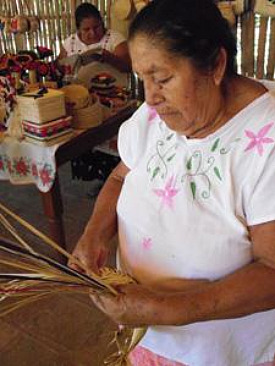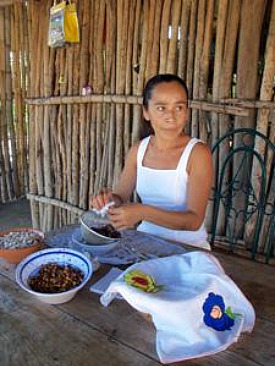The plan was this: We were going to spend the day visiting the rural villages located on the outskirts of Huatulco, Mexico, where we would learn about the local weaving craft, watch women make local fare, and tour medicinal herb and coffee farms. Our route on the towns and traditions tour would follow the one used by the cruise ships, but we were leaving an hour before the boats pulled into port, allowing us to avoid the tourists spilling off the ships.
Our first stop was at a homestead where a woman showed us how to make tortillas and tamales. The “kitchen” contained a large area designed specifically for frying up generous quantities of traditional foods and plenty of space for several people to stand. It was decorated with dried gourds and showed no signs of dishes or other cooking ingredients.
 We ate our tortillas beneath a large shade structure outdoors. Large tables set up around the edge of the area were covered in handcrafted goods. Local women stood off to the side with their children as people fingered the products while snacking on tortillas. Discreetly placed on the compound were two bathrooms—one for men, one for women, both with flush toilets. A sink with running water stood outside, between the two bathroom doors.
We ate our tortillas beneath a large shade structure outdoors. Large tables set up around the edge of the area were covered in handcrafted goods. Local women stood off to the side with their children as people fingered the products while snacking on tortillas. Discreetly placed on the compound were two bathrooms—one for men, one for women, both with flush toilets. A sink with running water stood outside, between the two bathroom doors.
“Do people actually live here?” one of the women I was traveling with asked our guide.
“Yes, this is where they live. This is where they cook. This is a traditional Oaxacan homestead,” the guide said.
While the other people in my group counted out coins for the women who manned the craft tables, I wandered around the side of the house. A bike was propped up against a nearby building; it was surrounded by empty beer bottles. Chickens ran wildly in the yard. A primitive drop toilet with a door hanging on a hinge provided relief for the family.
I walked to the next compound where I observed pencil-drawn pictures on a dispensary door of people washing their hands and covering their coughs. Behind the building was a simple playground for local children.
[social]
After everyone else had finished shopping, we got back in the van and sped up and down the rough dirt roads, traveling to a home where we learned about weaving for a few brief moments before being encouraged to shop, a medicinal garden with tip jars at every turn and a coffee plantation selling its beans. Flush toilets, running water, and modern shade structures and seating were available and conveniently situated at each location while cluttered clotheslines and traditional housing hid in the background.
Before each stop, our guide reminded us that we didn’t have to buy anything but that tourist dollars allowed locals to stay in business. Along the way we passed three packed vans carrying cruise tourists to the very same stops we had just left. I doubt we were the only people encouraged to spend money.
What is cultural tourism?
 Travel that involves the integration of travelers with locals has become known as cultural tourism.
Travel that involves the integration of travelers with locals has become known as cultural tourism.
Ideally, this kind of travel allows tourists to explore a destination in a more authentic manner. It encourages people to learn about and discover otherwise unknown cultures while financially supporting local communities and helping them to maintain and continue their traditions.
Cultural tourism is found in the hills of Oaxaca as well as the mountainous regions of Central Asia, the Maasai Mara in Kenya and countless other places around the world. It sounds good in theory, and has actually had a positive impact in many instances.
When tourists are introduced to an indigenous culture, they provide economic opportunities and employment in areas of the world that might otherwise struggle financially. I suppose it’s even possible that cultural tourism has allowed particular cultures to thrive in instances where they might have otherwise faded into nonexistence.
But in my opinion, cultural tourism walks a very fine line between sharing local traditions and exploiting them.
Does cultural tourism exploit the people it is supposed to help?
On our towns and traditions tour, I couldn’t help but feel a little uneasy about the fact that catering to tourists required additional buildings to be built and modern plumbing to be installed even though the locals themselves did not appear to take advantage of either. Their homesteads felt like living history museums more than homes, with their spotless kitchens, bench seating and tables of goods spread out for purchase. Though we were experiencing traditional cooking, crafts and gardening, I felt like we were doing so in the context of tourism, not culture.
 And yet, as we bounced along the road, passing small houses made of adobe where children and chickens ran freely, I began weighing the merits of cultural tourism in the context of sustainability. Satisfying tourists’ interests in order to provide economic stability is not the answer to responsible cultural tourism. Every van that drives down the dirt road and traveler who visits the homesteads leaves behind waste, traces of their own cultures and a carbon footprint. This kind of travel requires delicate planning so that sustainability and authenticity are maintained and local traditions, cultures and ways of life are protected.
And yet, as we bounced along the road, passing small houses made of adobe where children and chickens ran freely, I began weighing the merits of cultural tourism in the context of sustainability. Satisfying tourists’ interests in order to provide economic stability is not the answer to responsible cultural tourism. Every van that drives down the dirt road and traveler who visits the homesteads leaves behind waste, traces of their own cultures and a carbon footprint. This kind of travel requires delicate planning so that sustainability and authenticity are maintained and local traditions, cultures and ways of life are protected.
But if cultural tourism helps a particular tribe or indigenous group maintain its traditions, isn’t that a form of sustainability? Without cultural tourism in the hills outside of Huatulco, would the local communities have been able to afford to build a dispensary and playground? Would they have running water and electricity?
If the vans of cruise passengers weren’t passed from homestead to homestead by van, would the farmers who grew cacti and coffee be able to afford to grow their crops without a captive audience interested in buying? If the women weaving hats and fans weren’t able to sell their products to out-of-town patrons several times a week, would they continue to make fiber dyes and weave, and would they find any reason to teach their children how to do the same?
Pushing that idea even further, if the people living in yurts in Mongolia, mud huts in the Kenyan desert and adobe homes in Oaxaca weren’t able to make a living off their land, would they give it all up and move to the closest big city, where they would be more likely to find mainstream jobs? A changing indigenous culture starts with one generation and slowly seeps through time until tribal languages are lost and traditional recipes are commercialized and turned into quick-eat microwave meals.
So were the stops of the towns and traditions tour really people’s homes? Yes, but with modifications to please the wayward traveler. Did we learn about authentic traditions? Yes, but with mass market appeal. With that in mind, is there a way to balance authentic cultural practices with outsiders’ interests in exploring them in a manner that is mutually—and equally—beneficial? That’s the question I don’t know how to answer.
Further reading:
- How to Be a Better Traveler
- How to Travel Like a Local in Indonesia
- The Art of Traveling in Developing Countries
photos by JoAnna Haugen and may not be used without permission